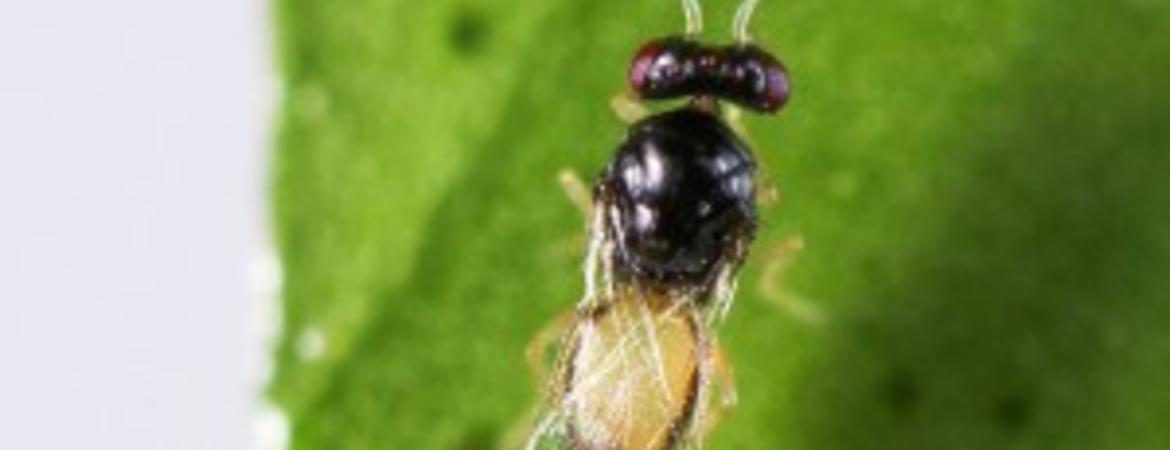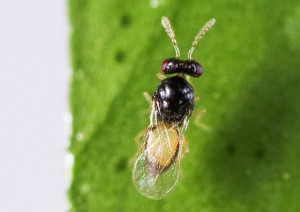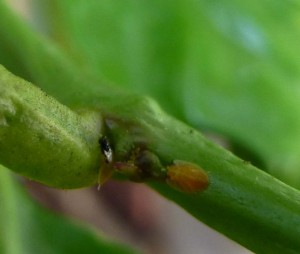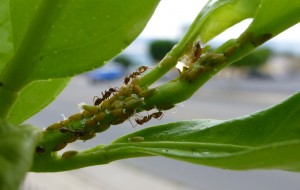

The Problem: Tamarixia radiata, a tiny parasitic wasp has been imported into California from the Punjab of Pakistan to attack nymphs of Asian citrus psyllid (ACP), a serious citrus pest that has established wide spread populations in the counties of Los Angeles, San Bernardino, and Riverside (significantly smaller populations are known in Imperial and San Diego Counties too). Releases of Tamarixia commenced in December 2011 after USDA-APHIS cleared this natural enemy for release from the Quarantine Facility at the University of California Riverside. Since these initial releases in December, approximately 8,500 parasitoids have been released at about 50 different sites in Southern California by July 2012.
The Biocontrol Release Program: Parasitoid releases have been made in the cities of Azusa, Bell Gardens, Chino, Duarte, Fontana, Los Angeles, Mira Loma, Montclair, Ontario, Pico Rivera, Pomona, Rialto, Riverside, San Bernardino and Whittier. In these areas, citrus in residential gardens with ACP infestations were selected for parasitoid releases. Ideally release sites had lemons or limes, and other types of citrus too (e.g., oranges or grapefruit.) Lemons and limes are good hosts for ACP because they tend to produce a lot of flush growth that is favored by ACP females for egg laying, and lemons in particular, tend to produce flush growth more frequently when compared to other types of citrus (e.g., oranges.)
A mixture of different citrus types in gardens is desirable for a release site because it increases the possibility that there will be flush present on different citrus types at different times of the year that will be available for ACP can infest. We’ve also noticed that semi-regular pruning of citrus, good fertilization, and decent watering schedules can also help garden citrus produce strong flush.
Tamarixia Recoveries: Parasitoids have been recovered at about 4-6 release sites in Azusa and Bell Gardens, and some of these sites have not received parasitoid releases for 2-3 months suggesting that Tamarixia has likely established and is breeding on its own (the life cycle of the parasitoid is about 12-14 days depending on the temperature). DNA analyses suggest that the parasitoids that have been recovered from release sites have a unique genetic signature that is very similar to the parasitoids imported from Pakistan for the biological control of ACP in southern California. This result tentatively suggests that the parasitoids recovered from release sites are most likely those that were mass reared and released by the

University of California Riverside. Further, at one site in Azusa, it appears that Tamarixia has self-dispersed about 65 m from where it was released on citrus and it established new populations on ACP infested curry plants (curry plants are really good hosts for ACP too.) Additionally, the genetic signal from captured parasitoids is reasonably diverse which suggests that the foreign exploration, rearing, and release program at UCR has preserved a lot of genetic variation which could be very important for local adaptation by parasitoids to citrus growing areas from the coast to the inland valleys.
How Does Tamarixia Kill ACP? Tamarixia can kill ACP nymphs in two different ways. First is parasitism, and in this instance a female parasitoid lays an egg underneath a fourth or fifth instar (instar refers to the developmental stage of the nymph, so a fifth instar is the fifth nymphal stage before the nymph becomes an adult) nymph. These larger nymphs are most preferred by Tamarixia for parasitism. When the egg hatches, the parasitoid larva begins to feed on the under surface of the ACP nymph. Eventually the Tamarixia larva will completely excavate the body cavity of the ACP nymph, and it will pupate inside the empty shell of its host. Often you will see beige colored silk strands radiating out from the edge of a mummified ACP nymph. The parasitoid larva spins this silk to hold the ACP shell onto to the twig that the nymph was feeding on. This ensures that the husk of the host won’t fall off the twig prematurely exposing the parasitoid pupa to predators or inclement climatic conditions. Once the parasitoid has finished pupating, the adult wasp chews a perfectly circular hole near the head of the mummified ACP husk and the parasitoid emerges. After emergence it will mate and if it is a female, it will hunt for more ACP nymphs to attack. The presence of these emergence holes near the head of dried up ACP nymphs is very strong evidence that Tamarixia emerged from that host.
The second way Tamarixia can kill ACP nymphs is by host feeding. When Tamarixia host feeds, the female uses her ovipositor or egg laying tube at the posterior end of her abdomen to stab and mutilate the ACP nymph. This physical injury causes hemolymph (the equivalent of insect blood) to leak from the body and the parasitoid feeds on this fluid. Hemolymph is an important source of protein for female parasitoids, and the trauma of being stabbed then feed upon is sufficient to kill ACP nymphs. Only females can attack ACP nymphs in this manner because males lack an ovipositor because they don’t lay eggs.
Laboratory studies on the biology of Tamarixia suggest that through the combined actions of parasitism and host feeding, individual female parasitoids have the capacity to kill several hundred ACP nymphs during their life time.

Ants and ACP Biocontrol:At some release sites, ants, in particular the invasive Argentine ant, may have the potential to interfere with the biological control of ACP. Field observations strongly suggest that ants tend ACP nymphs and as a reward for guarding them, the ACP provide the ants honeydew, a sweet waste product that they excrete. We’ve also seen ants capture and eat Tamarixia parasitoids foraging in clumps or patches of ACP nymphs, and in some instances the ants have chased Tamarixia off the patch if they could not catch it. It is possible that when ACP infestations are heavily tended by ants, some sort of ant control may be needed if the natural enemies are to attack the pests. This problem is not unique to ACP, honeydew producing scales and mealybugs, for example, are also tended by ants, which in turn hampers effective biological control of these pests too.
Future Plans: Monitoring and release programs are ongoing, and UC Riverside is now ramping up the mass production of Tamarixia for expanded releases throughout ACP infested zones. It is hoped that as more Pakistani Tamarixia are released in southern California greater establishment rates will occur and natural spread will begin to fill in areas between release sites.